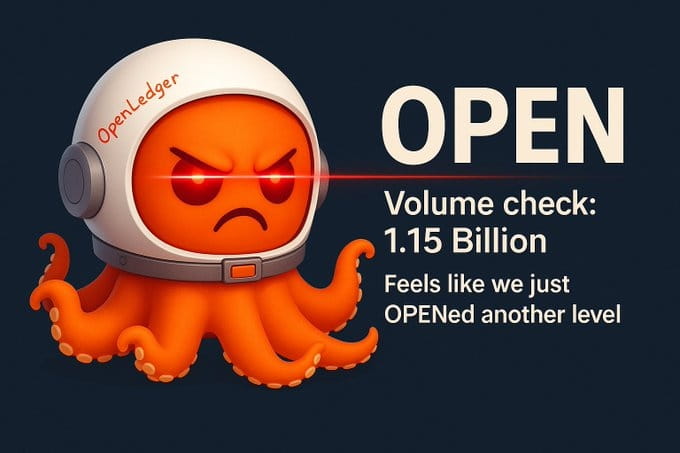Any blockchain project that only 'writes a good white paper and shouts catchy slogans' finds it hard to win genuine market trust. Users care more about: who is backing it? Is the technology reliable? Is there capital support? Will there be real landing space in the future?
@OpenLedger The answer given is very straightforward — there is code, a team, capital, and a vision.
Today, in this article, we won't talk about concepts, but rather discuss the hard power behind this project.

1️⃣ Technical architecture highlights: it's not just a 'shell', but a truly rewritten layer of AI dedicated blockchain.
Many AI+Web3 projects are actually just layering a smart contract or using IPFS to store some data, with core logic still centralized.
But OpenLedger is different, it directly rebuilds a chain-level infrastructure specifically designed for AI inference. Mainly includes:
Inference blockchain: a complete execution environment supporting model operation, invocation, and settlement
OpenLoRA architecture: used for deploying lightweight models with low resource consumption, improving execution efficiency
Attribution engine: a key module for tracking data usage and revenue distribution
Modular AI stack: facilitates developers to build a complete model economic system from the bottom up
This entire system is not an external tool, but runs natively on-chain. Simply put, OpenLedger is not 'integrating AI', but building a blockchain for AI.
2️⃣ Team background: from major tech companies like Aptos, Uniswap, Google, Meta
Whether a project is good or not, the team's experience is the best indicator. The core members of OpenLedger are distributed as follows:
Has engineers who have worked in L1 architecture development at Aptos
Has a former contract architect from Uniswap, involved in designing multiple mainstream protocol logics
Has former Google Research members focused on natural language processing
Has technical backbones who have worked at Meta for many years, involved in edge computing and model deployment
Also has Web3 project experience from the a16z startup training camp
This is not a 'rookie team self-research' shoddy assembly, but a group of technically experienced professionals truly building a native AI blockchain.
3️⃣ Investor exposure: early capital support is stable and the goals are clear
According to multiple public sources, institutions currently participating in or paying attention to OpenLedger include:
Maven11 Capital: Europe's top crypto fund, focusing on modular and AI tracks
Apex Capital: early-stage, continuously investing in 'AI + decentralization' direction
Berachain team members & development community: participating in ecological collaboration, providing underlying chain connectivity channels
Several well-known angel investors, including personal wallet addresses that have invested in EigenLayer and Celestia, are publicly displayed on-chain
Although the project has not announced large-scale funding rounds, its direction and potential have already gained early recognition from many industry insiders.
4️⃣ Why are technical institutions willing to invest in OpenLedger?
From the perspective of investors, OpenLedger has several significant advantages:
Not creating an 'AI model trading platform' that plays with concepts, but building a complete AI invocation economic network
Using the attribution mechanism as the core to tackle data incentive issues, which is a problem most AI projects cannot avoid or dare to touch
Deploying models at the chain level architecture without relying on external APIs, with high autonomy and controllability
System design considers the incentive closed loop for multiple roles such as inference nodes, data uploaders, and model developers, not a single point explosion, but systemic growth potential
Before the proposition of 'AI models running on-chain' becomes the next Web3 hotspot, OpenLedger has already laid a lot of groundwork.
5️⃣ Ecological cooperation and future layout: not just a project, but more like a public chain infrastructure
OpenLedger's route is not just to be a platform, but to build an 'on-chain AI model sharing network'.
From the current development path, they are already promoting the following collaborations:
Connects with chains like Berachain, Ethereum, BSC for open staking and deployment logic
Collaborates with multiple open-source data platforms to introduce authorized data source interfaces
Preparing to launch an SDK for developers, supporting model invocation, data binding, governance participation, and one-click integration
Promoting more subnet access under the Datanet system, expanding scenarios for text, image, audio, and video multimodal data participation
The ultimate goal is to build OpenLedger into an on-chain AI operating system of 'model as a service, data as equity'.
Summary $OPEN
OpenLedger does not start by 'issuing tokens' and then stacking projects, but roots down and grows up from the mechanism design and system capabilities.
It has an independently developed inference execution layer,
There is a clear attribution revenue-sharing mechanism,
There is a team with rich practical experience,
There is early trust endorsement from capital,
And there is a real system layout that serves developers, contributors, and node operators.
This is not a 'short-term topic', but building infrastructure for the AI model circulation market of the next 5-10 years.
For long-termists, this is the real opportunity window worth participating in.#OpenLedger

